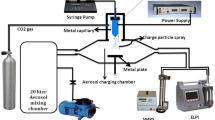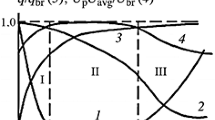The possibility of intensifying the processes in gas-dispersed systems with coagulated particles of different dimensions and the efficiency of air purification depend on the characteristics of the field created by electrodepositing plants. This work was carried out with a view of optimizing the parameters of electrodepositing systems to increase the rate of aerosol cloud deposition in an air medium. The theoretical and experimental studies are oriented to improving the methods of removing harmful aerosol formations in the air space by exposure to external electrostatic fields. This paper describes experimental investigation of coagulation and deposition of aerosol particles by inducing external fields in a closed volume with account for different technical parameters of devices for trapping different kinds of finely divided particles. To obtain the dispersed and concentration characteristics of aerosol, use is made of the method of searching for the solution in the form of a multiparameter function of the size distribution of particles realized as part of a laser measuring complex.
Similar content being viewed by others
References
V. I. Timoshenko and N. N. Chernov, Deposition and Depositing Accumulation of Industrial Gases [in Russian], Rosizdat, Rostov-on-Don (2004).
V. L. Lanin, Increase in efficiency of ultrasonic cleaning with the directed action of electric field in liquid environments, Electron. Process. Mater., No. 4, 60–65 (2008).
P. Intra, A. Yawootti, and N. Tippayawong, Electrostatic evaluation of a unipolar diffusion and field charger of aerosol particles by a corona discharge, Part. Sci. Technol., 31, 1–11 (2013).
M. Alonso and F. J. Alguacil, Particle size distribution modification during and after electrical charging: Comparison between a corona ionizer and a radioactive neutralizer, Aerosol Air Qual. Res., 8, No. 4, 366–380 (2008).
M. Domat, F. E. Kruis, and J. M. Fernandez-Diaz, Investigations of the effect of electrode gap on the performance of a corona charger having separated corona and charging zones, J. Aerosol Sci., 68, 1–13 (2014).
A. Jaworek, A. Krupa, and T. Czech, Modern electrostatic devices and methods for exhaust gas cleaning: A brief review, J. Electrostat., 65 (3), 133–155 (2007).
J. Park, J. Jeong, C. Kim, and J. Hwang, Deposition of charged aerosol particles on a substrate by collimating through an electric field assisted coaxial flow nozzle, Aerosol Sci. Technol., 47 (5), 512–519 (2013).
M. N. Khaikin and A. A. Chernikov, Scattering of thermal fogs on automobile roads with the aid of electrostatic fi lters, Meteorol. Gidrol., No. 3, 51–59 (2002).
V. N. Uzhov, Purification of Industrial Gases by Electrostatic Precipitators [in Russian], Khimiya, Moscow (1987).
Yu. I. Sanaev, Dust Removal from Gases by Electrostatic Precipitators [in Russian], Kondor-Éko, Semibratovo (2009).
O. B. Kudryashova, A. A. Pavlenko, B. I. Vorozhtsov, S. S. Titov, V. A. Arkhipov, S. S. Bondarchuk, E. V. Maksimenko, I. R. Akhmadeev, and E. V. Muravlev, Remote optical diagnostics of nonstationary aerosol media in a wide range of particle sizes, Photodetectors, Chapter 15, Rijeka, Croatia: InTech (2012), pp. 341–364.
A. A. Zhirnov, Automatization of joint processing of experimental data in aerosol particles dispersity sensors, Yuzhno-Ural′sk. Nauchn. Vestn., No. 4, 59–63 (2018).
A. L. Tukmakov, Numerical simulation of the drift of solid particles in the case of resonance vibrations of a gas in an open channel, Akust. Zh., 55, No. 2, 247–255 (2009).
M. Yu. Stepkina, O. B. Kudryashova, and I. R. Akhmadeev, Experimental study on precipitation of aerosol particulates under combined external fields, J. Phys.: Conf. Ser., 1129, 1–8 (2018).
Author information
Authors and Affiliations
Corresponding author
Additional information
Translated from Inzhenerno-Fizicheskii Zhurnal, Vol. 93, No. 4, pp. 825–830, July–August, 2020.
Rights and permissions
About this article
Cite this article
Stepkina, M.Y., Kudryashova, O.B., Antonnikova, A.A. et al. Application of Electrostatic Effect for Cleansing Finely Divided Aerosol from Air. J Eng Phys Thermophy 93, 796–801 (2020). https://doi.org/10.1007/s10891-020-02181-w
Received:
Published:
Issue Date:
DOI: https://doi.org/10.1007/s10891-020-02181-w




